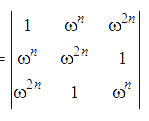The value of (1−ω+ω^2 )^ 5 +(1+ω−ω^ 2 )^ 5 where ω and ω^ 2 are the complex cube roots of unity, is
32
16
8
0
The correct Answer is:a
To solve the problem, we need to evaluate the expression (1−ω+ω2)5+(1+ω−ω2)5, where ω and ω2 are the complex cube roots of unity.
Step 1: Understand the properties of cube roots of unity
The complex cube roots of unity satisfy the equation:
1+ω+ω2=0
From this, we can derive:
ω+ω2=−1
ω2=−1−ω
ω=−1−ω2
Step 2: Rewrite the expressions
We will rewrite the terms (1−ω+ω2) and (1+ω−ω2) using the properties of ω.
1. For 1−ω+ω2:
1−ω+ω2=1+ω2−ω=1+(−1−ω)−ω=1−1−2ω=−2ω
2. For 1+ω−ω2:
1+ω−ω2=1+ω−(−1−ω)=1+ω+1+ω=2+2ω=2(1+ω)
Since 1+ω=−ω2:
1+ω−ω2=2(−ω2)=−2ω2
Step 3: Substitute back into the expression
Now we substitute back into the original expression:
(1−ω+ω2)5+(1+ω−ω2)5=(−2ω)5+(−2ω2)5
Calculating each term:
(−2ω)5=−32ω5
(−2ω2)5=−32(ω2)5
Step 4: Simplify ω5 and (ω2)5
Using the property ω3=1:
ω5=ω3+2=ω2
(ω2)5=(ω2)3+2=ω
Thus, we have:
−32ω5=−32ω2
−32(ω2)5=−32ω
Step 5: Combine the results
Now we combine the results:
−32ω2−32ω=−32(ω+ω2)
Using ω+ω2=−1:
−32(−1)=32
Final Answer
The value of (1−ω+ω2)5+(1+ω−ω2)5 is:
32
The complex cube roots of unity satisfy the equation:
1+ω+ω2=0
From this, we can derive:
ω+ω2=−1
ω2=−1−ω
ω=−1−ω2
We will rewrite the terms (1−ω+ω2) and (1+ω−ω2) using the properties of ω.
1−ω+ω2=1+ω2−ω=1+(−1−ω)−ω=1−1−2ω=−2ω
1+ω−ω2=1+ω−(−1−ω)=1+ω+1+ω=2+2ω=2(1+ω)
Since 1+ω=−ω2:
1+ω−ω2=2(−ω2)=−2ω2
Now we substitute back into the original expression:
(1−ω+ω2)5+(1+ω−ω2)5=(−2ω)5+(−2ω2)5
Calculating each term:
(−2ω)5=−32ω5
(−2ω2)5=−32(ω2)5
Using the property ω3=1:
ω5=ω3+2=ω2
(ω2)5=(ω2)3+2=ω
Thus, we have:
−32ω5=−32ω2
−32(ω2)5=−32ω
Now we combine the results:
−32ω2−32ω=−32(ω+ω2)
Using ω+ω2=−1:
−32(−1)=32
The value of (1−ω+ω2)5+(1+ω−ω2)5 is:
32
Topper's Solved these Questions
- MODEL TEST PAPER - 17Book:ICSEChapter:MODEL TEST PAPER - 17Exercise:SECTION -B
Explore 10 Videos
- MODEL TEST PAPER - 17Book:ICSEChapter:MODEL TEST PAPER - 17Exercise:SECTION -C
Explore 10 Videos
- MODEL TEST PAPER - 10 Book:ICSEChapter:MODEL TEST PAPER - 10 Exercise:SECTION - C
Explore 5 Videos
- MODEL TEST PAPER - 20 Book:ICSEChapter:MODEL TEST PAPER - 20 Exercise:SECTION - C
Explore 10 Videos
Similar Questions
The area of the triangle (in square units) whose vertices are i, ω and ω2 where i=√−1 and ω,ω2 are complex cube roots of unity, is
View SolutionValue of 100∑k=1(ik!+ωk!), where i = √−1andω is complex cube root of unity , is :
View Solution1a+ω+1b+ω+1c+ω+1d+ω=1ω where, a,b,c,d, ∈ R and ω is a complex cube root of unity then find the value of ∑1a2−a+1
View SolutionIf y1=max||z−ω|−|z−ω2∣∣∣, where |z|=2 and y2=max||z−ω|−|z−ω2∣∣∣, where |z|=12 and ω and ω2 are complex cube roots of unity, then
View SolutionThe common roots of the equation x3+2x2+2x+1=0and1+x2008+x2003=0 are (where ω is a complex cube root of unity)
View SolutionIf 1,ω,ω2 are the cube roots of unity, then △

is equal to.....
View SolutionIf A=⎛⎜⎝1111ω2ω1ωω2⎞⎟⎠ where ω is a complex cube root of unity then adj−A equals
View SolutionTwo dices are rolled and numbers r1 and r2 are chosen. Let 1+ωr1+ωr2=λ (where ω is a complex cube root of unity). Then
View SolutionIf ω is a cube root of unity, then
1+ω= …..
View SolutionProve that the value of determinant ∣∣ ∣ ∣∣1ωω2ωω21ω21ω∣∣ ∣ ∣∣=0
where ω is complex cube root of unity .
View Solution

